Four Tibetan Traditional Regions
There are the four following Tibetan traditional regions:
1) U-Tsang in the central region of Tibet
2) Ngari in the far west region of Tibet
3) Kham in the west of Sichuan
4) Amdo in Qinghai.
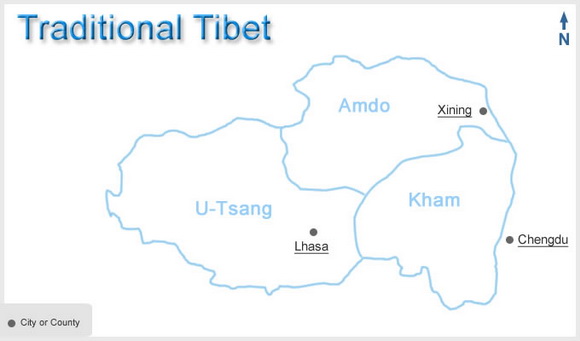
So, Kham is one of the four Tibetan traditional regions. Jiarong Tibetans ( Gyarong Tibetans 嘉绒藏族) are one of the branches of the ethnic Tibetans in Kham.
Where do the Jiarong Tibetans live?
Today most of the Jiarong Tibetans live in Danba County (Rongtrak), Jinchuan, Xiaojin (Tsenlha), Heshui (Trochu), Ma’erkang (Barkham), Wenchuan (Lunggu) and Kangding (Dartsedo).
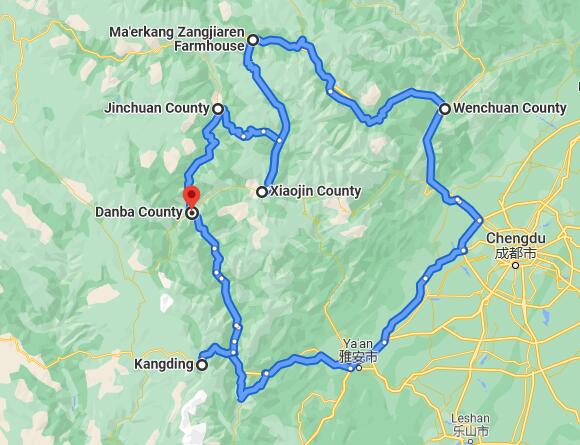
Except for a small number of Jiarong Tibetans living nomadic lifestyle on the high plateau ( over 2500m ), most Jiarong Tibetans are farmers doing barley farming between 1800m and 2500m with fertile land and much more temperate climate.
Where do the Jiarong Tibetans come from?
Jiarong Tibetans are one of branches of the ethnic Tibetans, and now living mainly in Danba area. There are two origins for the word “Jiarong”(嘉绒) , also go by “Gyarong རྒྱལ་རོང་”.
One means “Jia Mo Cha Wa Rong” (嘉莫察瓦绒), or simplified as “Jiarong”, an old administrative region referring to the area surrounding the sacred mountain known as Moerduo Sacred Mountain (墨尔多神山), where Jiarong Tibetans now largely live. The other means “the Queen of the Valley” referring to the lost Danba Eastern Kingdom of Women (丹巴东女国) that once existed in Danba area.
Jiarong Tibetans are the descendants of the locals mixed with the frontier soldiers and migrants from Tubo Kingdom (618-842 A.D.).
Tubo Kingdom witnessed one of the most powerful periods in Tibet’s history. The great Tibetan leader Songtsan Gambo unified over 10 separate tribes during Tang Dynasty (618-907) in China, and established the Tubo Kingdom. He chose his capital in the present-day Lhasa. The Tubo Kingdom set the foundation for today’s prosperous Tibetan culture and Tibetan Buddhism.
Over its 200 hundred years of rule, the Tubo Kingdom was engaged in expanding its territory towards the east and took up large parts of the Tang Empire.
But after the collapse of Tubo Kingdom, these soldiers were unable to return home and remained in regions now known as Qinghai and Sichuan including Danba.
They have some unique ways as a separate branch of the Tibetan ethnic group distinct from other Tibetans in the aspects of their origin, housing, clothing, dining, custom, festivals,culture and a dialect of their own.
Dan Ba Jiaju Tibetan Stockaded Village
On October 19, we visit Dan Ba Jiaju Tibetan Stockaded Village, a typical Jiarong Tibetan village, about 3 km north of the Zhanghuzhen (Zhanggu Town, the seat of Danba County.
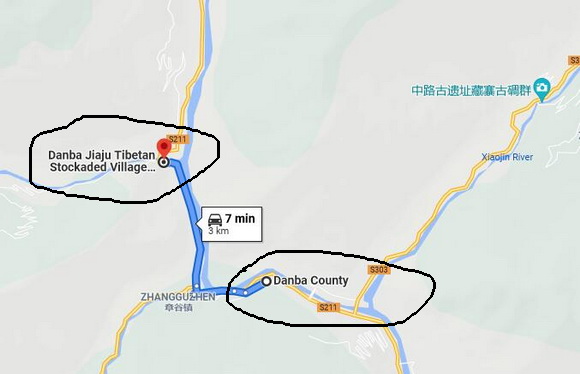
There are a slew of Jiarong Tibetan villages in the surrounding mountainous areas. Jiaju Tibetan Stockaded Village (甲居藏寨) with 270 Tibetan houses is oft-lauded as the most grandeur and beautiful.
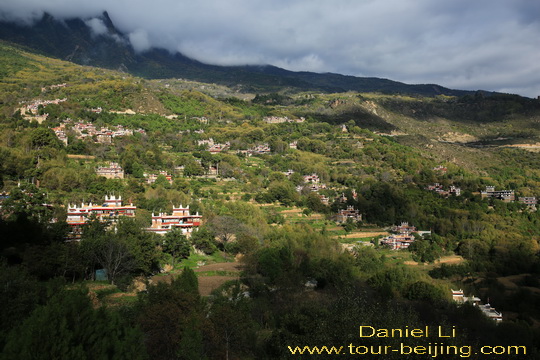
When first seeing the village cascading from the hillsides of the Kapama Mountains down to the bottom of the Dajin River, we are still shocked at its beauty though we already have had some anticipation of the much hyped village in advance.
Some stone houses are clustered and some are perched separately in the green forested hill slopes with terraced agricultural fields.
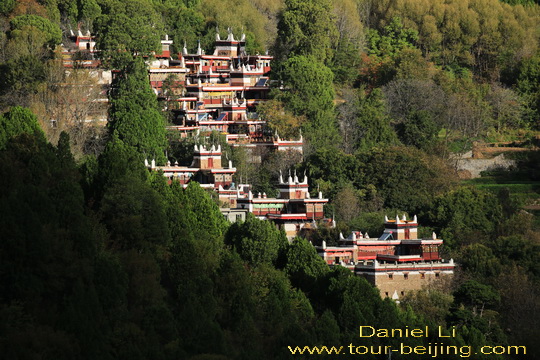
some village houses are perched separately on the green forested hillsides.
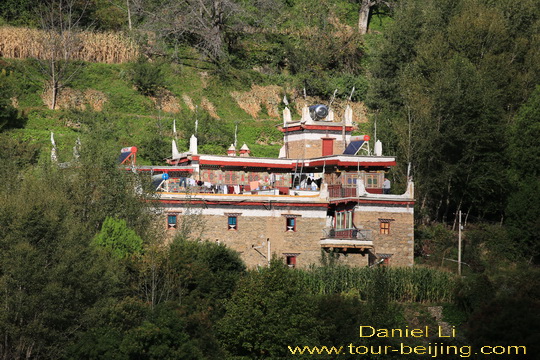
The Jiarong Tibetan Village Houses clinging to the forested mountain slopes, tier above tier
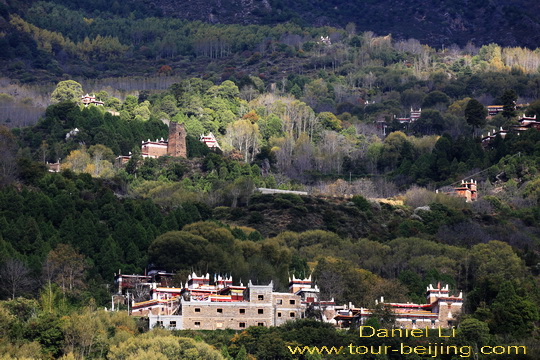
Jiarong Tibetan Blockhouses
These Tibetan fortress-like houses are mainly made of stone and wood. These stone houses are built using the quarried stones with a tradition of Qiang people.
The stone houses once served as a defensive strong point against any enemy, a kind of blockhouses popular in Jianrong Tibetan villages. The traditional Tibetan blockhouse has three floors.
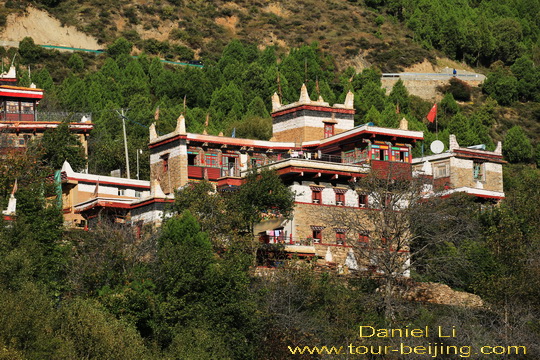
The top floor is often used for storing grain, corn and hanging clothes; the middle floor are the living rooms for human beings, and the first floor is the place for livestock and fodder.
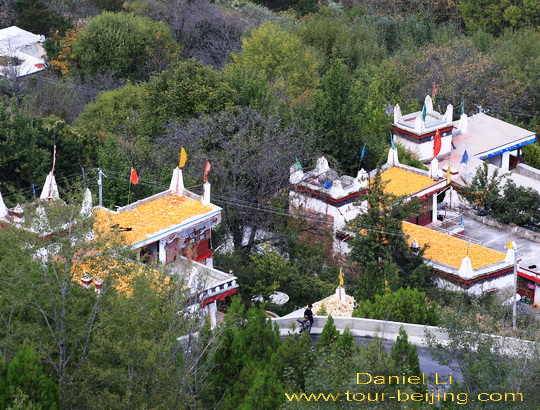
Jiarong typical blockhouses are square in shape with narrow upper side and broader lower side, a style of quadrangle dwelling houses.
The walls are made by stones, enhanced by glutinous rice and slaked lime with white and black colors.
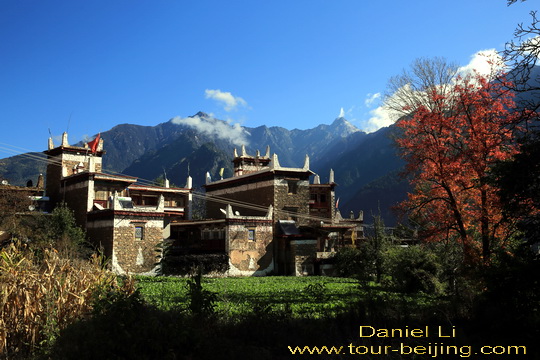
The Jiarong Tibetan blockhouses are flat-roofed except for glorious parapets in the four corners that are sometimes adorned with prayer flags.
The four upturned eaves are representative of the four sacred mountains in Tibet.
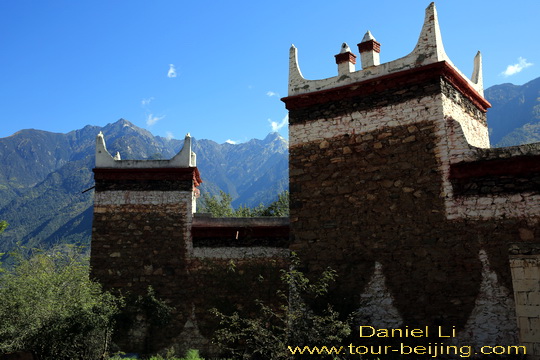
The massive stone houses have upper floors accessible by ladders, the only way into the vertical construction in the past.
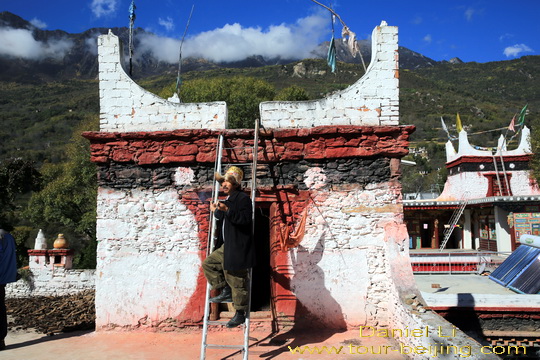
Jiarong Tibetan homes are all decorated with flowers. Galsang Flower is a must for local villagers. As the legend goes, no matter who you are , if you can find the eight-petal Galsang flower, then you can find happiness.
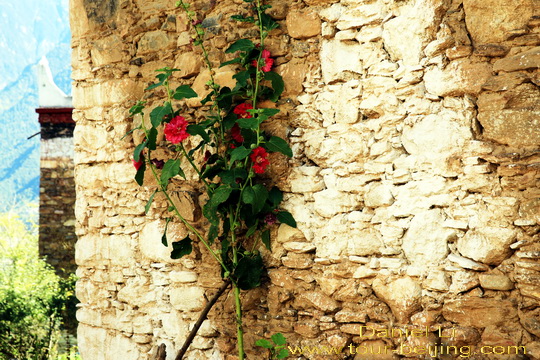
Our unnamed host of the Jiarong Tibetan home we have just visited poses for us to take a picture of him who is sitting by his house overlooking the mountain slope, smoking and enjoying his bucolic life.
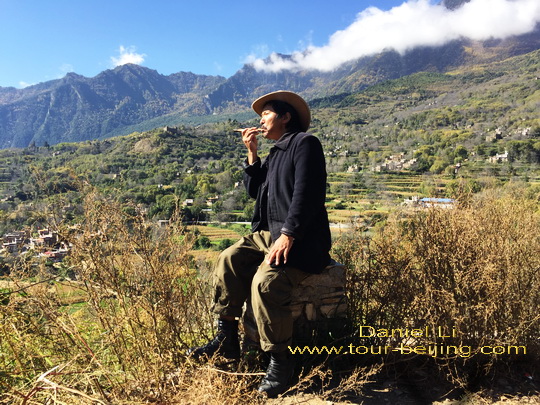
Add-On
Drive from Hanzhong to Ya’an
Ya’an Night View
Most Beautiful Sky Road in China
Moxi Old Town ( Tips, Photos & Map)
Hailuogou Glacier Camp No.04 (Tips,Photos & Map)
Hailuogou Glacier Camp No.03 (Tips, Photos & Map)
Kangding (Tips, Photos & Map)
Drive from Kangding to Xinduqiao
Drive from Xinduqiao to Danba
Jiarong Tibetan Blockhouses
Jiarong Tibetan Ancient Watchtowers
Drive from Xinduqiao to Yajiang
Drive from Yajiang to Litang
Drive from Litang to Daocheng
Drive from Litang to Batang
Drive from Batang to Mangkang
Drive from Shangri-la to Daocheng
Drive from Daocheng to Yading
Yading Brings You Inner Peace
Hassle-free Chengdu & Sichuan Guided Tours
If you don’t want to go the do-it-yourself route and prefer the hassle-free escorted tours, here are some options for Chengdu and Sichuan guided tours:
Chengdu tour
Chengdu Car Rental with Driver
Create My Chengdu Trip
Jiuzhaigou Tour
Sichuan Tour
Further Readings
Top 10 Attractions in Chengdu
Best Time to Visit Chengdu
Chengdu Airport
Railway stations in Chengdu
Chengdu Taxi
Chengdu Research Base of Giant Panda Breeding (Tips, Photos & Map)
How to visit Wuhou Shrine
How to visit Du Fu Thatched Cottage
How to visit Jinsha Site Museum
How to visit the tomb of Wang Jian in Chengdu
How to Visit Wangjiang Pavilion Park in Chengdu
How to visit Qingyang Palace in Chengdu (Tips, Photos & Map)
How to Visit Jinli Street
How to visit Kuan Alley and Zhai Alley
Qintai Road, Qintai Gujing Chengdu (Tips, Photos & Map)
Shaoling Road Bar Street Chengdu (Tips, Photos & Map)
Jiuyanqiao Bar Street in Chengdu (Tips, Photos & Map)
The Old Teahouse in Pengzhen Town, Chengdu
Bipenggou, Bipeng Valley (Tips, Photos & Map)
When is the best time to visit Jiuzhaigou?
Best Places to Visit Autumn Leaves in Sichuan
Top 10 Places to Visit in Sichuan
Ruoergai Grassland, my first trip to Ruoergai Grassland
Any questions, just drop a line.





